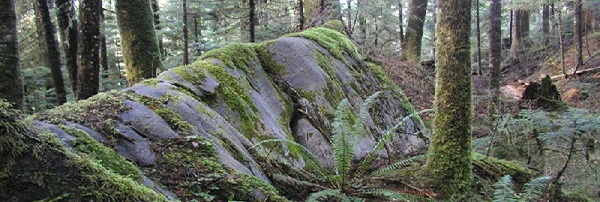Lesson 2: Karst Features
On this page
- Lesson objectives
- An important note about surface karst features
- Surface vs. subsurface karst feature
- Classifying surface karst features by hydrological function
- Classifying surface karst features by form
- Subsurface karst features
- Where can I learn more about karst features?
- Test your knowledge
Lesson objectives
The focus of this lesson is karst features. Karst features are distinctive landforms that develop in karst landscapes when water dissolves bedrock. They vary in size from small centimeter-scale rocky relief features to macro-scale landforms measured in kilometers. By the end of this lesson, you should be able to:
- Identify and classify some common karst features
- Explain why caves are not diagnostic karst features
- Describe the different ways that dolines (karst sinkholes) form
- Explain why not all dolines pose collapse hazards
Before we begin: An important note about karst features
Karst features are often referred to as if they were discrete, isolated phenomena surrounded by solid bedrock. One can easily get this impression when observing karst features in the field, especially if the vegetation and soil cover are intact.
When the vegetation and soil have been removed, such as after a wildfire, it becomes evident that what looked like discrete karst features when they were covered by soil and vegetation are simply areas of the epikarst where greater or lesser dissolution has occurred. Many would be difficult to identify as typical karst features – once the soil and vegetation are removed, what remains would be a rocky, undulating surface with many solutionally enlarged fissures and joints.
For management purposes, B.C.’s karst guidance documents refer to karst features as if they are discrete phenomena. This is because the transfer of water and materials from the surface to the subsurface is often more intense at such easily identifiable sites. However, it is important to remember that the transfer of water into the subsurface can also happen across the surface of the broader karst landscape, regardless of whether identifiable karst features are present.
Surface vs. subsurface karst features
Surface karst features are defined in B.C. as those features that can be viewed on the ground up to the threshold of daylight in subsurface openings. (Karst Inventory Standards and Vulnerability Assessment Procedures for British Columbia, V2 (KISVAP), p. 83). Subsurface karst features are those beyond the threshold of daylight. (KISVAP, p. 83).
Karst caves include both a surface and subsurface component. Cave entrances, a type of surface karst feature, are surface openings large enough to admit a human that connect to interior cavities containing a zone of complete darkness (KISVAP, p. 88). The dark zones of caves are examples of subsurface karst features.
Karst features can be sorted into broad categories of surface and subsurface features. Surface karst features are classified according to their hydrological function and form.
Classifying karst features by hydrological function
Input features or “insurgences” are surface karst features where concentrated flows of water are introduced into the subsurface environment. Such features often occur at the geological contacts with less- or non-soluble rocks. Water flowing on the surface from non-karst areas will often disappear or “sink” into subsurface openings when it reaches the karst.
The most obvious and easily observable example of an insurgence is a swallet where a concentrated flow of surface water exploits an existing bedrock opening and flows into the subsurface.
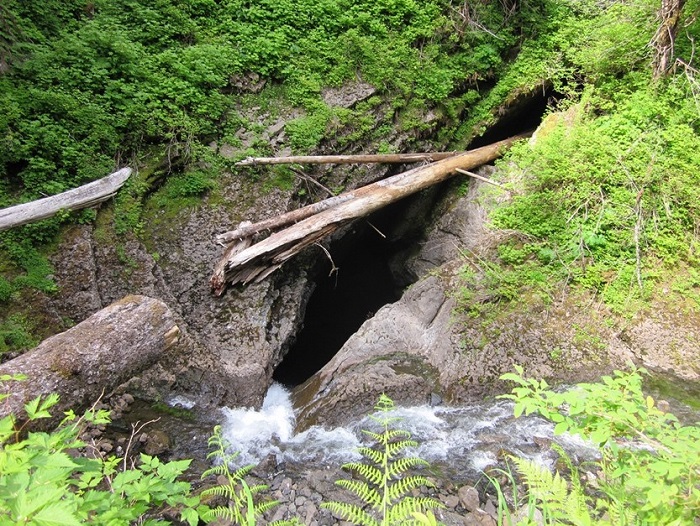
Photo above: This small stream disappears underground at a karst insurgence, usually a swallet (KISVAP, p. 84). (Photo by C.L. Ramsey)
Other features, such as dolines (karst sinkholes), can be broadly classified as “input features” because they represent areas where bedrock has been preferentially dissolved by water draining into the subsurface. Dolines are discussed in greater detail in the negative relief features section.
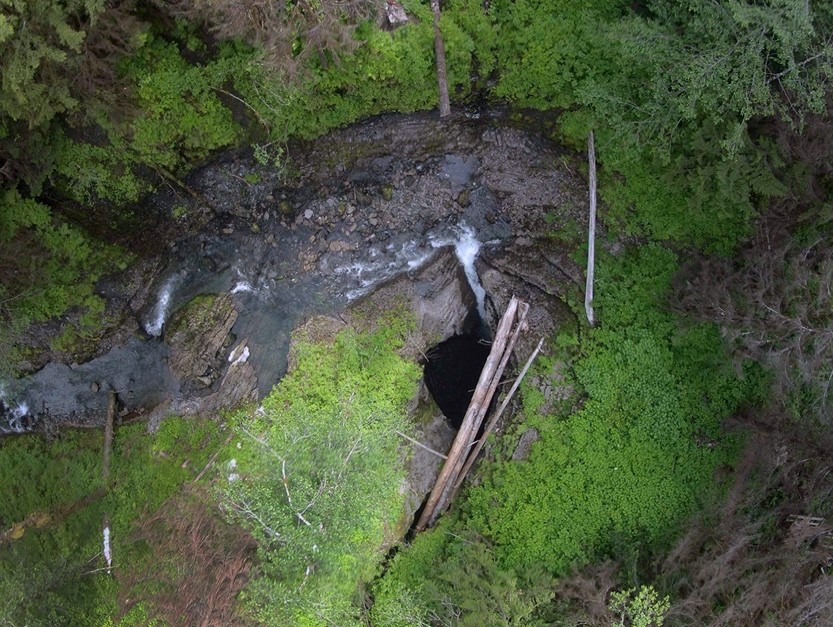
Photo above: Cave entrance receiving a sinking stream. (Photo by P.A. Griffiths)
Click here: A video showing water sinking into karst (Video by P.A. Griffiths)
Output features or “exsurgences” transfer water and/or materials from the subsurface to the surface at concentrated sites such as karst springs.
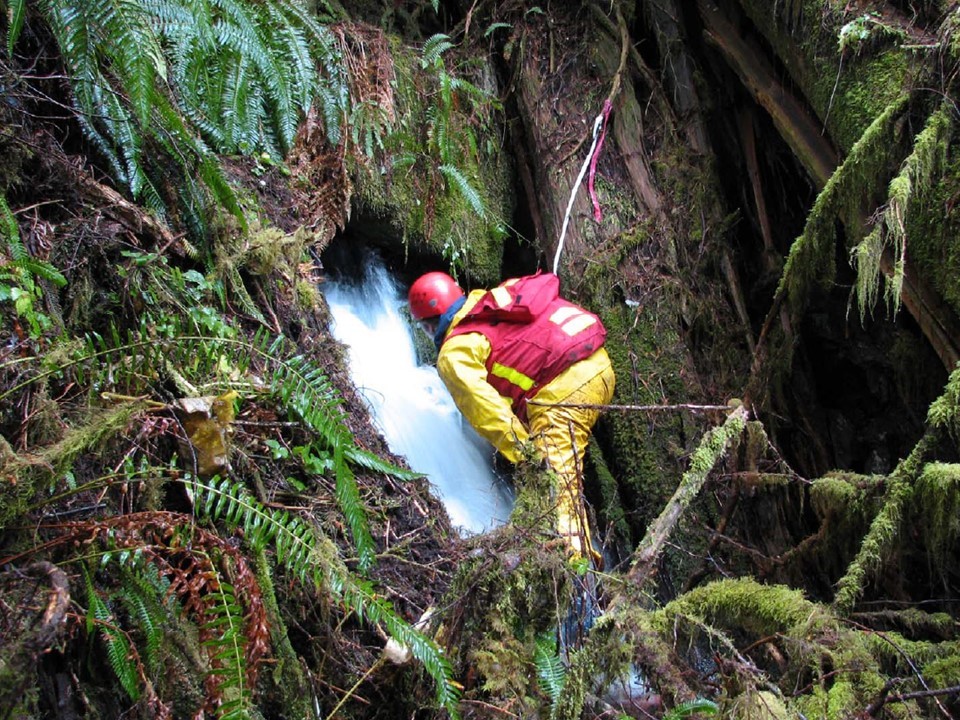
Photo above: Water flowing out of a karst spring. (Photo: Province of B.C.)
Classifying surface karst features by form
Surface karst features can be broken down into the following broad categories:
- Negative relief karst features
- Positive relief karst features
- Linear karst features
- Karst intersection features
- Micro-scale karst features
- Cave entrances
Negative relief karst features
Negative relief karst features are features that are lower than the surrounding landscape. Examples include dolines (karst sinkholes), shafts, grikes, karst windows, and karst ponds.
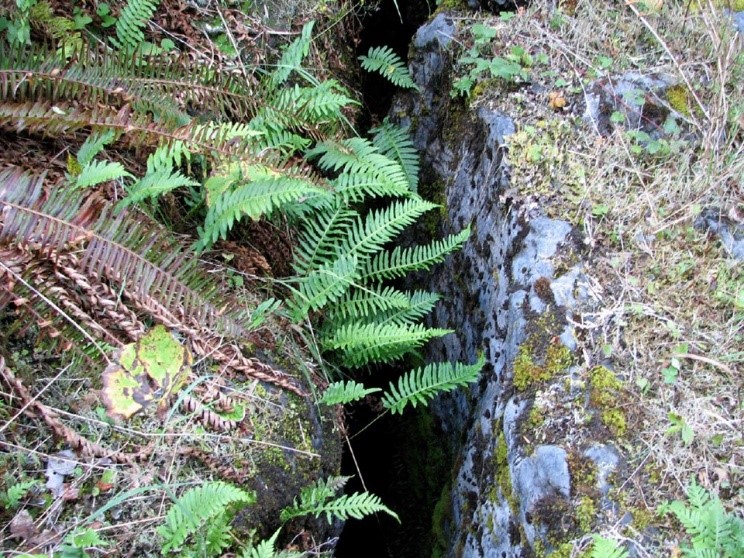
Photo above: A grike: this is defined as a deep, narrow, vertical or steeply inclined, rectilinear slot with almost parallel sides. Grikes are usually found in a bedrock outcrop and are caused by solution along a joint (KISVAP, p. 86). (Photo: Province of B.C.)
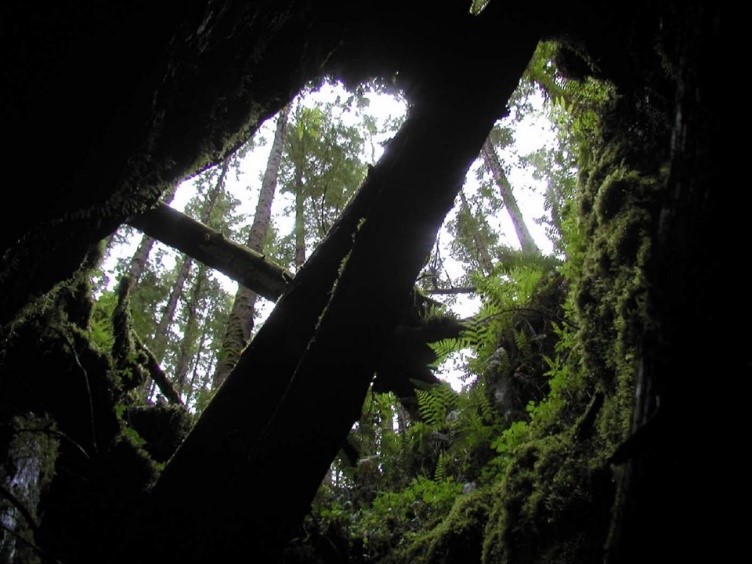
Photo above: A shaft: this is defined as a deep solution hole, generally circular in outline, having vertical or nearly vertical walls. It tends toward a cylindrical shape and is without a passage or chamber leading from it (KISVAP, p. 86). (Photo: Province of B.C.)
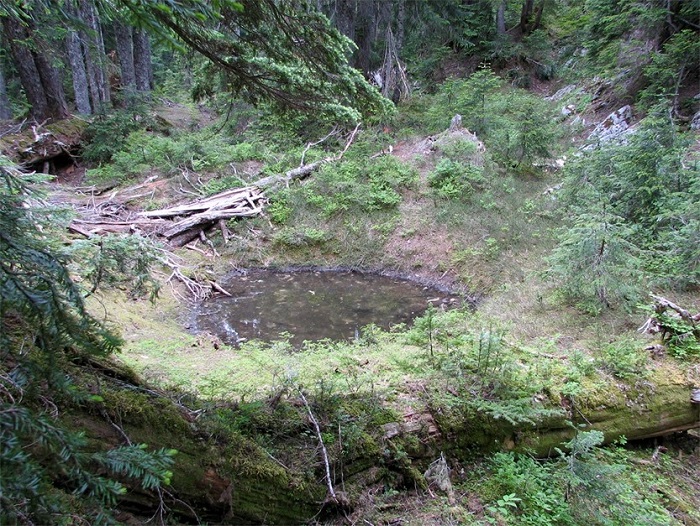
Photo above: A karst depression enclosing a standing water body (KISVAP, p. 86). (Photo by P.A. Griffiths)
Dolines
Dolines (karst sinkholes) are natural closed depressions that are oval-shaped or circular in plan view; funnel- or bowl-shaped in cross section. They can range in size from a few metres to more than a kilometer in diameter. Many karst scientists consider dolines to be the classic diagnostic karst feature.
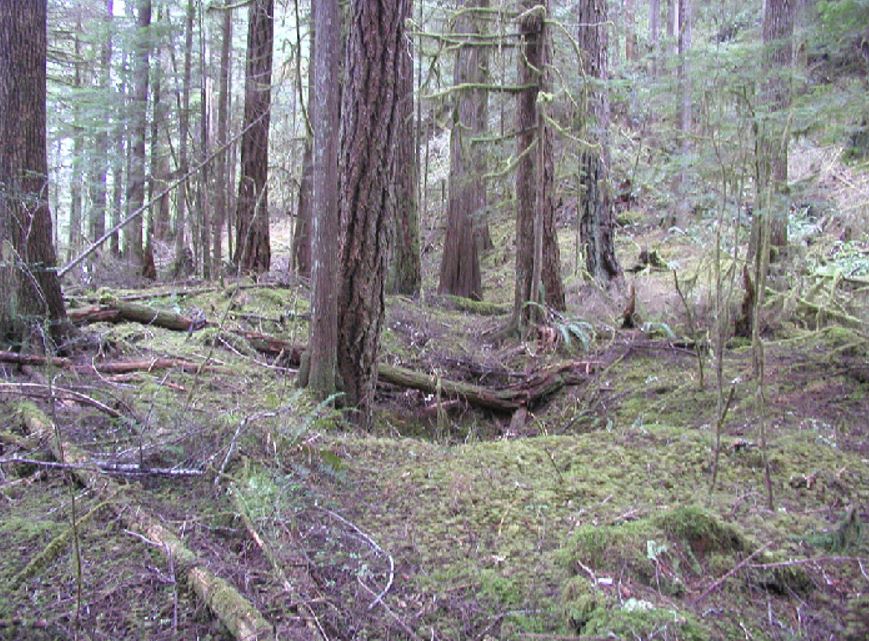
Photo above: Doline (also known as a “karst sinkhole”): a topographically closed karst depression, wider at the rim than it is deep. It is commonly of a circular or elliptical shape with a flat or funnel-shaped bottom (KISVAP, p. 86).
Dolines are among the most common features in coastal B.C. karst areas. They are readily identifiable sites of concentrated hydrological recharge and play an important role in the overall functioning of karst systems. As such, dolines warrant a detailed discussion.
Many people have seen news stories about houses or roadways swallowed up by spectacular sinkhole-forming collapses. While some dolines form via bedrock collapsing into underlying cavities and in some parts of the world this poses serious safety and engineering concerns, it is not true that collapse is a major safety concern wherever dolines are present. This is because collapse is not the only way dolines can form.
In coastal B.C., for example, many dolines are actually “solution dolines” that form as subsurface water in the epikarst drains into enlarged fissures and joints in the doline’s base. In these types of dolines, surface flows of water or an atmospheric opening in the bottom need not be present for the doline to form. In solution dolines, the collapse hazard can be nil.
Did you know? The terms “sinkhole” and “doline” are often used as if they are interchangeable, but this is not necessarily the case. The term sinkhole is often used to describe any collapse feature, regardless of whether it formed because of karst processes. All dolines, on the other hand, are the result of karst processes and are therefore karst features. Sinkholes can be the result of many different processes and may or may not be karst features.
'Sinkhole'
- A term commonly used in North America, Australia, and New Zealand
- Often applied to collapse features, but not all collapse features occur in karst, hence are not necessarily karst features
- The meaning is ambiguous, hence potentially confusing because it can include non-karst features
'Doline'
- The term used in Europe and elsewhere to describe karstic depressions; possibly more widely used than “sinkhole” on a global scale
- Applied to depression features resulting from the dissolution of bedrock
- Refers specifically to depression features of karstic origin, hence the meaning is unambiguous
Solution dolines begin to form in areas in the epikarst that might be more fractured, more intensely developed, or along geological contacts. Water, either on the surface or within the epikarst, flows into any existing fractures preferentially. The conduits in the underlying epikarst enlarge, causing more water to drain though those pathways. It works like a feedback loop and eventually a depression begins to form in the epikarst surface. Since they are not necessarily related to large underground void spaces that may collapse, solution dolines often pose no collapse hazards. Most dolines in coastal B.C. karst appear to be solution dolines.
Collapse dolines form when bedrock spanning a subsurface void is subject to mechanical failure. The bedrock collapses and falls into the void, leaving a depression on the surface. Collapse can occur abruptly or proceed slowly over time. Collapse dolines are common in gypsum karst and may be more prevalent in areas of northwestern and southeastern B.C. where gypsum occurs.
Suffosion dolines form when fine sediments on the surface are evacuated into the subsurface of karst. The effect is somewhat like what happens when sand flows out of an hourglass and the result is a depression forming in the cover material. Suffosion dolines differ from collapse dolines in that they form in unconsolidated sediments while collapse dolines form in bedrock.
Other processes can also contribute to doline formation. In fact, it is usual for more than one mechanism to contribute to the development of a single doline over its lifespan.
All dolines are hydrologically active or potentially hydrologically active features.
Among karst scientists who specialize in the study of dolines, there is general consensus that dolines function as active input features into karst hydrological systems.
“The term sinkhole, or doline, implies a form, a function, and a basic mechanism of origin. The form is a closed basin – one having no surface drainage outlet. The function is to transmit surface water underground into the karstic aquifer. The origin is basically by solution of the underlying karst host rock.”
Source: Beck, B. F., 1988. Environmental and engineering effects of sinkholes – the processes behind the problems. In: Y. Daoxian, ed. Proceedings of the 21st IAH Congress: Karst Hydrogeology and Karst Environmental Protection. Guilin, China, 10-15 October 1988.
The way dolines function in karst systems is to concentrate and transmit water into the subsurface. This is true whether they have visible holes in the bottom, visible surface water flowing into them, or whether they are sitting over top of a cave.
Many dolines are a bit like funnels with leaky sides. Even if you don’t see surface water draining into them on the surface, water is flowing into them from the surrounding epikarst. This is the reason why dolines without observable bottom openings or sinking streams continue to grow.
Positive relief karst features
Positive relief karst features are features that rise above the surrounding karst landscape. Often these features are formed when the bedrock around them is dissolved away. Examples of positive relief features include karst outcrops, hums (as pictured below), and karst ridges.
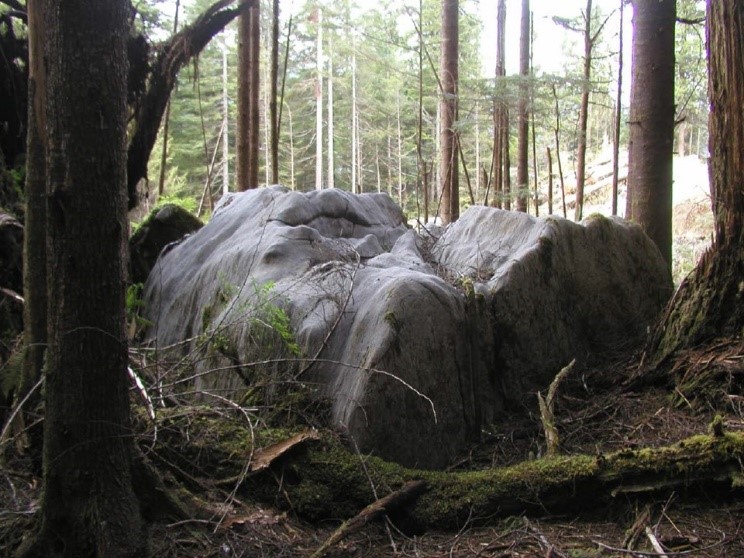
Photo above: Hum: a small residual hill of soluble rock standing above a recently eroded soluble rock surface (KISVAP, p. 87).
Linear karst features
Linear karst features are elongated features in the karst landscape. They can include:
- Flowing water features such as sinking streams, losing streams, or rising streams; or
- Features that always, sometimes, or never carry flowing water. Examples are dry gullies, karst canyons, dry valleys, and karst bluffs
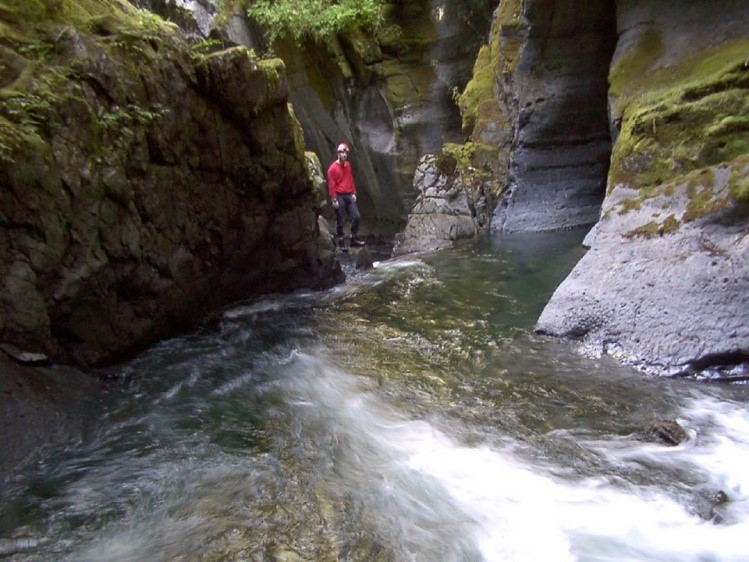
Photo above: Karst canyon: a deep and narrow gorge or ravine, with vertical or subvertical slopes underlain by soluble rock containing a perennial or intermittent stream (KISVAP, p. 85).
Karst intersection features
Karst intersection features connect the surface and subsurface of karst systems but do not necessarily receive or output concentrated flows of water.
Lateral intersection features are former subsurface conduits that are exposed when part of the bedrock that formerly covered them is dissolved away, exposing them to the surface. Examples include natural bridges and natural arches.
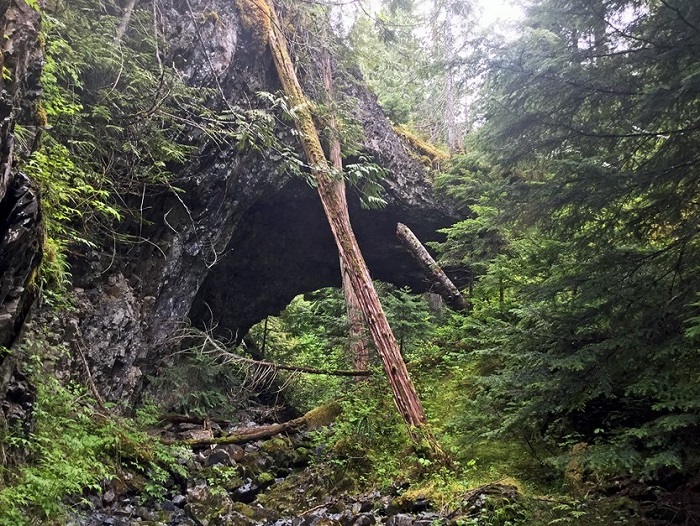
Photo above: A natural arch. (Photo by C.L. Ramsey)
Micro-scale karst features
Micro-scale karst features are solution-sculpted rock surfaces consisting of fluted, grooved or funnel-like forms that are typically less than a meter in scale. Like larger-scale karst features, they are produced by dissolution of bedrock. Karst scientists who specialize in the study of these micro-relief features refer to them collectively as “karren.”
Different types of karren will form under different sets of environmental conditions. Their shapes will change over time if those conditions change. For example, certain types of karren form only when covered with soil, hence their appearance from the surface is diagnostic of soil loss. However, once exposed to the atmosphere, the bedrock surface will begin to develop surface karren as the bedrock continues to dissolve.
Factors that can influence karren development (and hence their distinctive forms) include:
- Chemical composition and chemistry of the bedrock
- Climate
- Plant roots or biofilms
- Hydrology (that is, water flowing over the rock surface as sheet flow vs. concentrated flows vs. snow melt, etc.) and
- Presence or absence of soil cover
The subject of smaller-scale rocky relief features, such as karren, is very complex and cannot be covered in detail at an introductory level. However, it is worthwhile knowing about these smaller-scale features because they can be helpful in confirming the presence of karst.
Cave entrances
A cave entrance is part of a cave or cave system and may lie within one or more other surface karst features. For example, cave entrances are sometimes enclosed within a doline (karst sinkhole) and may receive a sinking stream. A cave entrance within a doline is an example of a nested or compound karst feature (KISVAP, p. 88).
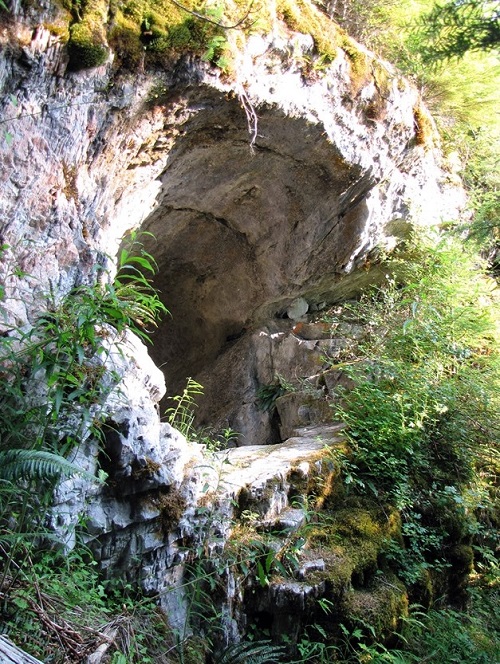
Photo above: Cave entrances are surface openings large enough to admit a human being, connecting to interior cavities that contain a zone of complete darkness. (Photo by C.L. Ramsey)
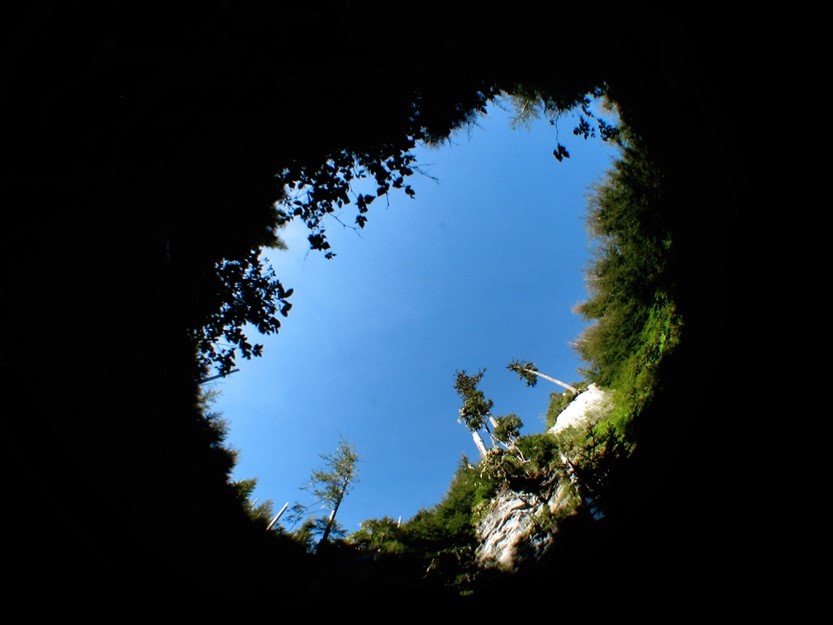
Photo above: Looking out from a cave entrance nested within a sinkhole (Photo by P.A. Griffiths)
Subsurface karst features
Caves
In B.C., caves in their entirety are defined as natural cavities in the earth that:
- Connect to the surface
- Contain zones of complete darkness
- Are large enough to admit a human (KISVAP, p. 72)
However, there are many types of subsurface karst cavities too small for humans to enter and are not definable as caves in B.C.. These smaller cavities play a major role in the functioning of karst systems and provide important habitat for diverse organisms.
Did you know? People often equate caves with karst, but caves are not diagnostic karst features.
Caves typically make up only a very small proportion of the underground void spaces in karst. In fact, it is possible to have karst without caves. It is also possible to have caves without karst.
Caves can form outside of karst by processes other than dissolving bedrock. For example, wave-cut caves along the seashore in non-soluble rock are not karst caves. Another example is lava caves, which are associated with volcanic activity.
Did you know? People sometimes use the term “karst formations” and “karst features” interchangeably. Strictly speaking, however, “karst features” is the term that should be used when referring to features formed by the dissolution of bedrock.
By contrast, the term “formations” usually refers to mineral deposits that form underground, such as stalactites and stalagmites. These underground deposits are more specifically known as “speleothems.”
Where can I learn more about karst features?
Detailed definitions of these karst features (and many more) can be found on pages 83 to 88 in Karst Inventory Standards and Vulnerability Assessment Procedures for British Columbia (Resources Information Standards Committee, 2003).
There is also a short, illustrated glossary of karst features on pages 62 to 64 in Appendix I of the Karst Management Handbook for British Columbia.
Test your knowledge
Self test (True/False)
Answer either True or False to check your understanding.
-
Dolines are not “active” when they do not have surface water courses flowing into them and have no obvious atmospheric openings.
-
Karst landscapes without obvious surface features can still transmit water and materials to the subsurface.
Answers
-
False. Dolines without any obvious atmospheric openings or surface watercourses flowing into them are nevertheless hydrologically active because they concentrate drainage from the epikarst to the subsurface.
-
True. Water falling directly onto the epikarst can infiltrate any overlying soil and drain into the subsurface regardless of whether identifiable karst features are present.
Go to Lesson 3 - Where Does Karst Occur?

